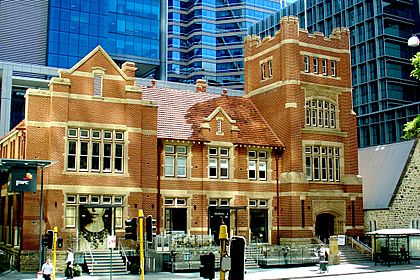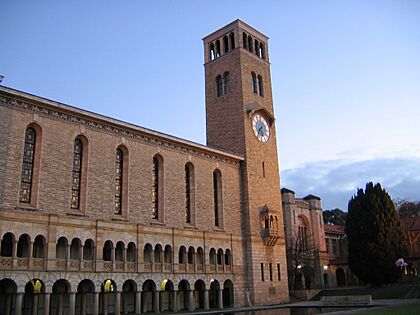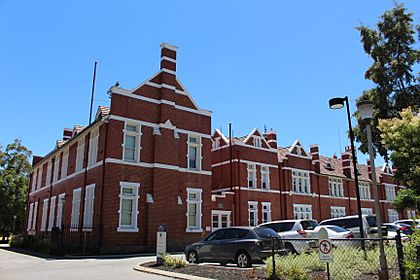Education in Western Australia facts for kids

Education in Western Australia is all about schools, colleges, and universities in our state. It includes both government-run schools and private ones. The Department of Education looks after public schools.
An important group called the School Curriculum and Standards Authority makes sure that what you learn in school, and how well you learn it, meets certain standards. They also handle your tests and certificates.
Western Australia has three main levels of education:
- Primary education: This is for younger kids in primary schools.
- Secondary education: This is for older students in high schools.
- Tertiary education: This is for adults at universities and TAFE colleges.
In Western Australia, you must go to school or be in training or a job from age six until you turn seventeen.
Contents
History of Education in WA
The first schools in Western Australia started around the 1830s. Many were small, with just one teacher. The oldest government school, Guildford Colonial School (now Guildford Primary School), opened in 1833 near the Swan River Colony.
By the 1850s, more schools appeared. Some teachers were even educated convicts who had earned their freedom. At first, you didn't need special qualifications to teach, just to be able to read and write. Many schools were run by nuns or single women.
The first school for Indigenous children, called Annesfield, opened in 1852 in Albany. It was started by a clergyman named John Wollaston and Anne Camfield.

In 1910, a special group suggested that Western Australia should have its own university. So, in 1911, the Parliament of Western Australia created the University of Western Australia (UWA). Students started attending UWA two years later. This meant people could get university degrees right here in WA.
In 1915, a man named James Miles started a special program for rural schools. He chose the Toodyay school to try out new ideas. Students learned practical skills like farming and gardening. Girls learned about preserving food and first aid. Teachers also used local information, like railway records, to teach subjects like maths and history. By 1922, 40 schools were part of this successful program.
For a long time, students in Years 11 and 12 took a big exam called the Tertiary Admittance Exam. This exam decided if they could go to university. From 1986, it was called the Tertiary Entrance Exam. In 2010, it changed to the Australian Tertiary Admission Rank (ATAR). This made it easier to compare student results across Australia. When you finish Year 12, you get a Western Australian Certificate of Education.
Primary and Secondary Education
Kindergarten and Preschool
In Western Australia, children can start school in Kindergarten. However, it's not compulsory. The next year, in Pre-primary, schooling becomes compulsory.
Pre-primary became a required part of schooling in 2013. This change helped Western Australia match other parts of Australia. Early childhood teachers follow special guidelines to help young children learn and grow. These guidelines focus on "Belonging, Being and Becoming."
Primary Schools
Primary education includes a preparatory year (Pre-primary) and then Years 1 to 6. Children can start Pre-primary if they will be five years old by June 30 of that year. All children must start school before they turn six.
Secondary Schools
Students in Western Australia attend a secondary school from Year 7 to Year 12. The age for starting high school was lowered in 2015, so students now begin in Year 7. This helps young teenagers develop and learn the Australian Curriculum.
Some schools have both primary and secondary students, from Kindergarten to Year 12. A few private schools might have separate "middle schools" for Years 7 to 9, with older students (Years 10-12) going to a "senior school" within the same place.
Special Programs for Talented Students
Many public high schools offer special programs for students who are gifted or have particular talents.
- Perth Modern School is the only public school in WA that only accepts students based on a special academic test.
- John Curtin College of the Arts in Fremantle focuses on the arts. Students can join programs like media arts, music, dance, and drama by passing a talent test.
- Other schools offer specific arts programs:
* Visual Arts: Applecross Senior High School, Balcatta Senior High School, Kalamunda Senior High School. * Dance: Hampton Senior High School. * Music: Churchlands Senior High School.
Selective Academic Program
The Selective Academic Program is a special program in some public schools. It gives extra opportunities for gifted students in English, humanities, mathematics, and science. Students in this program might take part in state, national, and even international competitions. They also get to learn leadership skills and explore university programs. This program is designed to challenge and support very bright students.
Schools with Selective Academic Programs
- Albany Senior High School
- Alkimos College
- Bob Hawke College
- Bunbury Senior High School
- Carine Senior High School
- Comet Bay College
- Duncraig Senior High School
- Fremantle College
- Governor Stirling Senior High School
- Harrisdale Senior High School
- Kelmscott Senior High School
- Melville Senior High School
- Online for students in country areas
- Shenton College
- Willetton Senior High School
Curriculum and ATAR
The School Curriculum and Standards Authority creates what students learn in Western Australia. They also make sure schools meet standards and manage national tests for reading and maths. The WA curriculum is similar to the Australian Curriculum, but it's made to fit students and teachers in Western Australia. Students in Years 11 and 12 work towards their Western Australian Certificate of Education.
Australian Tertiary Admissions Rank (ATAR)
The Australian Tertiary Admissions Rank (ATAR) started in 2010. It's a way to compare how well students do across Australia when they want to go to university. It helps universities decide who gets in.
Pathways After High School
After high school, you can choose different paths for further education. These are guided by the Australian Qualifications Framework (AQF). This framework helps to organise all types of education, from trade certificates to university degrees.
Technical and Further Education (TAFE)
Technical and Further Education (TAFE) colleges are run by the state government. TAFE offers many different courses, like short courses, Certificates (I, II, III, IV), Diplomas, and Advanced Diplomas. These courses teach you practical skills for specific jobs. Sometimes, TAFE also offers university-level courses.
Besides TAFE, there are also private training organisations. These can be:
- Companies that offer training.
- Training parts of big businesses.
- Groups that train people for specific industries.
- Community learning centres.
- High schools that offer job-focused programs.
These private organisations can be very small or very large. Many get money from the government to train apprentices, help people who need extra support, or teach skills in important areas.
All TAFE colleges and private training groups must follow national standards. They are regularly checked to make sure they are teaching well. The courses they offer are based on national qualifications, which are regularly updated.
Teachers and assessors in these programs must have a special qualification themselves. They also need to have real-world experience in the jobs they are teaching about.
University
Western Australia has five universities. The oldest is the University of Western Australia in Nedlands.
- Murdoch University has campuses in Murdoch and Rockingham.
- Curtin University has its main campus in Bentley.
- Edith Cowan University is newer and has campuses in different places. It includes the Western Australian Academy of Performing Arts in Mt Lawley and a campus in Joondalup, which also has the WA Police training facility.
- University of Notre Dame Australia is in Fremantle's historic West End. It is the only private university in Western Australia.
Universities in Australia mostly decide their own courses. However, they are starting to work together more to make sure their courses are similar.


